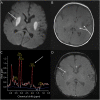Child Neurology: Infantile Biotin Thiamine Responsive Basal Ganglia Disease: Case Report and Brief Review
- PMID: 36657988
- PMCID: PMC10136005
- DOI: 10.1212/WNL.0000000000206832
Child Neurology: Infantile Biotin Thiamine Responsive Basal Ganglia Disease: Case Report and Brief Review
Abstract
Biotin thiamine responsive basal ganglia disease (BTRBGD) is an inherited autosomal recessive disorder that results from the inability of thiamine to cross the blood-brain barrier. It is considered a treatable condition if vitamin supplementation, most commonly with thiamine and biotin, is initiated early. BTRBGD can present as an infantile form, classical childhood form, or adult Wernicke-like encephalopathy. The infantile form is often the most severe and portends a worse prognosis with high mortality despite vitamin supplementation. We present a two-month-old who presented with irritability, opisthotonos, and abnormal eye movements who was found to have compound heterozygous variants in the SLC19A3 gene inherited in trans, including one known pathogenic intronic variant and a novel variant presumed to be pathogenic. She was therefore diagnosed with infantile BTRBGD. In this report, we discuss the differential for infantile BTRBGD, the clinical and radiologic features of BTRBGD, and describe a rapid, positive response to early vitamin supplementation in an infant with a likely pathogenic novel variant in SLC19A3.
© 2023 American Academy of Neurology.
Conflict of interest statement
The authors report no disclosures relevant to the manuscript. Go to
Figures

Similar articles
-
A case report of biotin-thiamine-responsive basal ganglia disease in a Saudi child: Is extended genetic family study recommended?Medicine (Baltimore). 2016 Oct;95(40):e4819. doi: 10.1097/MD.0000000000004819. Medicine (Baltimore). 2016. PMID: 27749535 Free PMC article.
-
Biotin-Thiamine-Responsive Basal Ganglia Disease.2013 Nov 21 [updated 2025 Jan 9]. In: Adam MP, Feldman J, Mirzaa GM, Pagon RA, Wallace SE, Amemiya A, editors. GeneReviews® [Internet]. Seattle (WA): University of Washington, Seattle; 1993–2025. 2013 Nov 21 [updated 2025 Jan 9]. In: Adam MP, Feldman J, Mirzaa GM, Pagon RA, Wallace SE, Amemiya A, editors. GeneReviews® [Internet]. Seattle (WA): University of Washington, Seattle; 1993–2025. PMID: 24260777 Free Books & Documents. Review.
-
Biotin-thiamine responsive basal ganglia disease in the era of COVID-19 outbreak diagnosis not to be missed: A case report.Brain Dev. 2022 Apr;44(4):303-307. doi: 10.1016/j.braindev.2021.12.003. Epub 2021 Dec 23. Brain Dev. 2022. PMID: 34953623 Free PMC article.
-
Are diagnostic magnetic resonance patterns life-saving in children with biotin-thiamine-responsive basal ganglia disease?Eur J Paediatr Neurol. 2018 Nov;22(6):1139-1149. doi: 10.1016/j.ejpn.2018.06.009. Epub 2018 Jul 9. Eur J Paediatr Neurol. 2018. PMID: 30054086
-
Biotin-responsive basal ganglia disease should be renamed biotin-thiamine-responsive basal ganglia disease: a retrospective review of the clinical, radiological and molecular findings of 18 new cases.Orphanet J Rare Dis. 2013 Jun 6;8:83. doi: 10.1186/1750-1172-8-83. Orphanet J Rare Dis. 2013. PMID: 23742248 Free PMC article. Review.
Cited by
-
Biotin-thiamine responsive basal ganglia disease: a retrospective review of the clinical, radiological and molecular findings of cases in Kuwait with novel variants.Orphanet J Rare Dis. 2023 Sep 5;18(1):271. doi: 10.1186/s13023-023-02888-y. Orphanet J Rare Dis. 2023. PMID: 37670342 Free PMC article.
-
Biotin Homeostasis and Human Disorders: Recent Findings and Perspectives.Int J Mol Sci. 2024 Jun 14;25(12):6578. doi: 10.3390/ijms25126578. Int J Mol Sci. 2024. PMID: 38928282 Free PMC article. Review.
-
Identification of novel mutations in TPK1 and SLC19A3 genes in families exhibiting thiamine metabolism dysfunction syndrome.Heliyon. 2024 Mar 6;10(6):e27434. doi: 10.1016/j.heliyon.2024.e27434. eCollection 2024 Mar 30. Heliyon. 2024. PMID: 38501011 Free PMC article.
-
Derivation of two iPSC lines (KAIMRCi004-A, KAIMRCi004-B) from a Saudi patient with Biotin-Thiamine-responsive Basal Ganglia Disease (BTBGD) carrying homozygous pathogenic missense variant in the SCL19A3 gene.Hum Cell. 2024 Sep;37(5):1567-1577. doi: 10.1007/s13577-024-01097-4. Epub 2024 Jul 9. Hum Cell. 2024. PMID: 38980565 Free PMC article.
-
An unusually mild case of biotin-thiamine-responsive basal ganglia disease.Mol Genet Metab Rep. 2023 Aug 27;37:101004. doi: 10.1016/j.ymgmr.2023.101004. eCollection 2023 Dec. Mol Genet Metab Rep. 2023. PMID: 38053933 Free PMC article.
References
-
- Ortigoza-Escobar JD, Alfadhel M, Molero-Luis M, et al. . Thiamine deficiency in childhood with attention to genetic causes: survival and outcome predictors. Ann Neurol. 2017;82(3):317-330. - PubMed
-
- Hassan TA, Mohey N. Reliability of MRI in detection and differentiation of acute neonatal/pediatric encephalopathy causes among neonatal/pediatric intensive care unit patients. Egypt J Radiol Nucl Med. 2020;51(1):62.
Publication types
MeSH terms
Substances
Supplementary concepts
LinkOut - more resources
Full Text Sources
